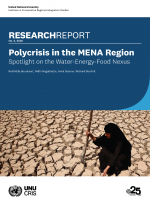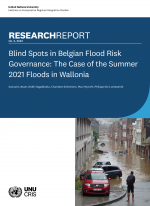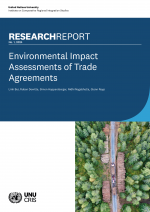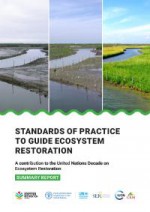From ‘Scarcity to Sustainability’: Strengthening the Regional Food-Water Nexus Amid Migration Challenges in Sub-Saharan Africa
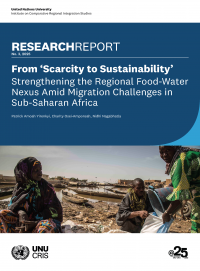
Africa faces significant challenges at the intersection of migration, food, and water insecurities, including the escalating and multifaceted impacts of climate change. The sub-Saharan African region is particularly vulnerable, with rising temperatures, changing rainfall patterns in the past, and extreme weather disrupting agriculture and water availability. Over-abstraction and consumption of water for farming and industry further depletes resources, fuels conflict, and exacerbates human displacement. Much of Africa’s agriculture is rain-fed, making it highly sensitive to changes in precipitation amount and frequency. Climate extremes are jeopardizing food production and increasing hunger and malnutrition. Limited investment in agriculture (on average just 4% of annual government budgets in the region) further weakens adaptive capacity, driving some segments of rural populations to migrate in search of more secure livelihoods. Water availability is uneven, with some regions facing severe scarcity while others lack infrastructure to manage overabundance. Furthermore, competing water use triggers conflicts at the local and subnational levels, destabilizing communities and undermining food and livelihood security. Overall, these challenges are worsened by climate change, rapid population growth, and major socio-economic disparities, necessitating urgent and more integrated ‘fit to context’ solutions.
This assessment presents a synthesis of the complex challenges of migration in general, food, and water insecurities in Sub-Saharan Africa gleaned from literature, shedding light on the interconnectedness and impact of these challenges across climate-vulnerable countries.
Four Key Trends Towards the Complex Relationships Between Migration, Water, and Food Security at Sub-Regional Levels
Migration impacts food security across various African countries, with both positive and negative outcomes depending on the socioeconomic, socio-political, and socio-cultural context.
Migration channeled financial remittances play a critical role in addressing both short- and long-term household food security challenges in sub-regions and states like Nigeria, northern Ghana, Malawi, Tanzania, and southern Ethiopia. The remittances provide financial resources for agricultural investments, healthcare, and education, thereby strengthening household resilience.
Migration also affects community food security negatively. In Zimbabwe, for instance, labour shortages and shifts in attitudes away from traditional agricultural practices disrupt the capability of communities to sustain food production.
While migration from dry, arid, and semi-arid regions to water-surplus areas is an established adaptive strategy in some communities, the interplay between water scarcity and climate change in countries such as Burkina Faso and Senegal has impacted migration opportunities, further complicating food security and resilience efforts.
We recommend a two-pronged approach that combines climate adaptation strategies to reduce forced migration with targeted migration-support interventions that enable safe, voluntary, and adaptive mobility, coordinated by regional multilateral organizations such as the African Development Bank, the Alliance for a Green Revolution in Africa, the Food and Agriculture Organization of the United Nations, the World Bank, the African Union, and the Economic Community of West African States and other stakeholders and major groups:
Strategy 1: Helping Communities Stay Where They Are
Boosting climate-smart farming: promote farming methods that are resilient to climate change, like using drought-tolerant crops, efficient irrigation, and sustainable soil practices. This helps ensure people have enough food and can maintain their livelihoods in times of stress related to water availability or income generation.
Strengthening social safety nets: expand programs like cash transfers and food aid, especially during droughts or floods, to provide financial stability and prevent people from being forced to move, overall augmenting the social support structures.
Improving early warning and action systems: develop better systems to warn communities about upcoming climate disasters (like droughts or floods) so they can prepare and buffer against the need to evacuate.
Building resilient infrastructure and restoring nature: invest in strong infrastructure, like better water storage, and restore natural areas such as forests and wetlands. In the long term, these actions protect communities from climate impacts and improve access to land and water resources.
Strategy 2. Supporting Migration as a Positive Choice
Creating rural job opportunities: support businesses, especially for young people in agriculture, to create jobs in rural areas and reduce the need to move to cities.
Facilitating safe migration: make it easier and safer for people to move within and between African countries for work (regulated regional migration pathways-RRMP), especially when climate change impacts their ability to earn a living in their current settings. This includes strengthening existing agreements on free movement, taking reference from ECOWAS (Economic Community of West African States- a regional political and economic union of 15 West African countries established in 1975 with the signing of the Treaty of Lagos).
Planned relocation: for communities in areas becoming uninhabitable, develop voluntary and well-managed plans for relocation, ensuring new homes and livelihoods value chains.
Supporting ‘context-specific needs’ of displaced populations: provide context-specific support systems to help those already displaced by climate disasters, including food, water, housing, and ways to earn a living, building on a comprehensive assessment (stocktake of skills).
Steering circular migration: support temporary (seasonal) migration for work, particularly during dry seasons, and encourage people living abroad to invest and share their skills back home to create circular loops that help support need-based mobility at local, sub-national, or regional levels.


